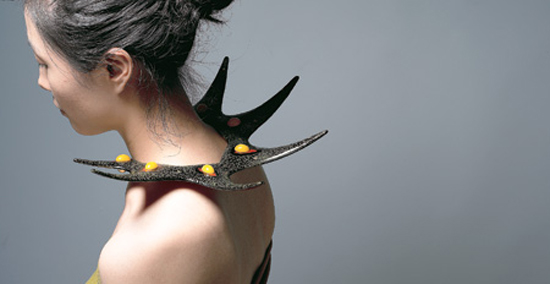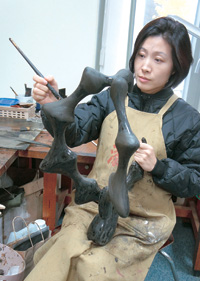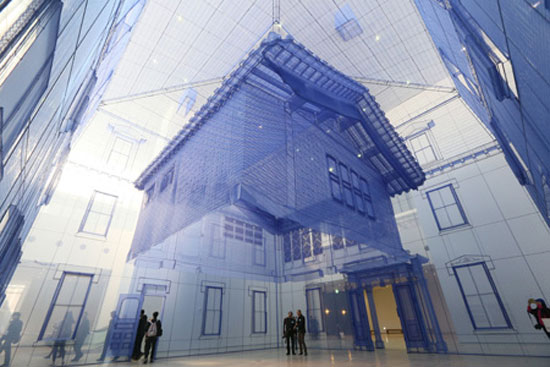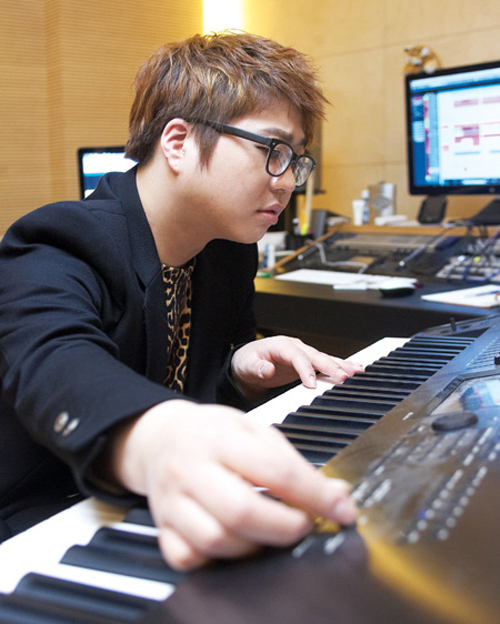- California Assembly OKs highest minimum wage in nation
- S. Korea unveils first graphic cigarette warnings
- US joins with South Korea, Japan in bid to deter North Korea
- LPGA golfer Chun In-gee finally back in action
- S. Korea won’t be top seed in final World Cup qualification round
- US men’s soccer misses 2nd straight Olympics
- US back on track in qualifying with 4-0 win over Guatemala
- High-intensity workout injuries spawn cottage industry
- CDC expands range of Zika mosquitoes into parts of Northeast
- Who knew? ‘The Walking Dead’ is helping families connect
Re-crafting tradition
‘Ottchil’ artist reshaping Korean craft with modern twists
By Chung Ah-young
The pieces of jewelry she designs are not trinkets of vanity or seduction.
If anything, they are more like weapons to repel rather than attract.
Her artworks are beautiful but have aggressive shapes that give those who wear them a sense of intense power.
Yun Sang-hee, a rising artist who has expanded the craft of “ottchil” or traditional lacquer art to making jewelry, finds herself subjected to social discrimination.
“I am a woman living in this small country which continues to suffer from a gender divide. I have a strong sense of having to defend myself from invisible social violence and prejudice. This pursuit is reflected in my artwork,” she said in an interview with The Korea Times.
Her craftwork ― such as necklaces, bracelets and rings ― are receiving attention both at home and abroad for its unconventional, modern design.
Yun originally majored in painting and printing at Ewha Womans University, went on to study metal work and jewelry at Seoul National University and ottchil crafts at Paichai University. She developed an interest in making jewelry while growing up as the daughter of a jewelry shop owner. She chose her special material, ottchil, because she wanted to experiment with various colors, coating diverse objects from metals to wood.
“I studied metal craftwork, but I don’t like the simple colors ― silver, bronze or gold. I wanted to create more diverse colors to express my ideas. I tried other coloring arts, but ottchil was the only answer,” she said. “Ottchil can be coated on any kind of material, including metals or woods. Also, its colors are diverse and unique. They well represent what I want to express,” she said.

“An Attack by Green Horns,” center, and “A Beautiful Footprint,” right, using ottchil or traditional lacquer art. (Courtesy of Yun Sang-hee)
Ottchil is found in nature and has outstanding durability which protects objects from decay and deformation for a long time.
Techniques for utilizing Ottchil technique have been developed and handed down from traditional lacquer artisans. But Yun uses new computer-aided technologies to modify traditional lacquer crafts. Her necklaces, bracelets and rings are created through innovative techniques, reflecting her understanding of the interrelations between the body and jewelry.
The visiting professor at Paichai University was invited to Tsinghua University in China last week to introduce her unique artistic creations using ottchil, along with other artists from Taiwan, Germany, the United Kingdom, Sweden and the Netherlands.
Although she has never studied art overseas, foreigners regard her work as unique objects with a strong identity. “Maybe they have seen Western style artworks very often. But my works, solely created in Korea, are not trying to be in a Western-style. It seems to appeal to them,” she said.
“I find that many foreign artists appreciate my work as very exotic and unique. They tell me that I am not affected by Western-style art, while holding on to my Korean identity,” she said.
Many Korean artists who have studied in Europe or the United States introduce what they learned there when they return home. “Koreans might find it very unique and advanced, but foreigners don’t think they are new. Korean artists who are studying and creating their artwork here should take pride in themselves because they have the ability to express what they struggle with and confront every day into modern artworks,” she added.
Making a difference
The sophistication and refinement of Korean ottchil craft can be found in “najeon chilgi,” traditional lacquer ware inlaid with mother-of-pearl. But Japan is credited with producing high quality lacquer artworks for various objects for a long time. And Vietnam is renowned for its lacquer paintings. China is eager to learn about such artistic techniques in order to catch up with its Asian neighbors.
“I am trying to make my work different from that made by the Japanese by applying it to sculptures which can convey my message. My works are experimental and contemporary,” she said.
In Japan, various art forms ― from traditional masterpieces to modern artworks ― are fully appreciated because there are consumers who purchase expensive and labor-intensive objects. So the Japanese artisans can concentrate on using traditional techniques.
But Korea only has a small number of traditional artisans sharing their techniques, and the ottchil crafts are losing popularity due to a lack of raw materials and the processes involved.
Yun said in Korea there is a clear division between traditionalists and revisionists. “It is very hard to narrow the gap. Traditionalists are trying to stick to their old techniques while revisionists are seeking a new medium. If they meet somewhere in between, there will be a great synergy effect,” she said.
Yun stressed that ottchil has great potential in both the cultural and industrial sectors. “It’s not Korea’s exclusive techniques. So we should strenuously reinvent it to suit modern tastes. While China and Japan are focusing on the technique and industries, we should make a difference through creative and innovative artistic experiments,” she said.
















